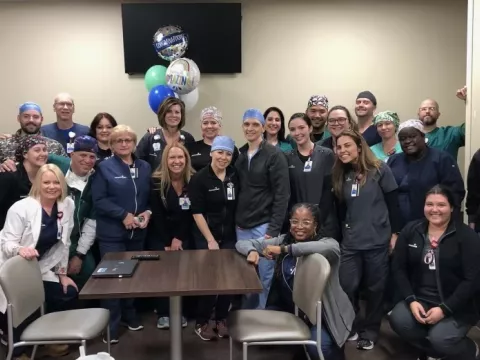- AdventHealth
This Physician's View opinion piece is written by Joseph Lopez, MD, chief of pediatric head and neck surgery at AdventHealth for Children.

On October 14, 2022, 13-year-old Zoe Rodriguez came into the AdventHealth for Children emergency room with severe neck pain. Upon evaluation, we found a rare 5 cm benign dermoid tumor with CTNNb1 mutation in her neck that was crushing her jugular vein and displacing her carotid artery. While not malignant (fortunately), the tumor was still complex and potentially life-threatening. Prompt and precise surgical planning was critical to safely and successfully resecting it and ultimately, restoring her health, function and physical appearance.
Pediatric patients with head and neck tumors like Zoe’s aren’t little adults and should not be treated as such. These young patients benefit significantly from specialized surgical and multidisciplinary care that considers their smaller anatomy and unique pathophysiology as well as their future growth and development to achieve optimal long-term outcomes. This includes having a deep understanding of their breathing, mastication, swallowing, speech, hearing, vision, dental and craniofacial development. Children also benefit greatly from pediatric-specific pre- and post-operative care.
In fact, it is cases like Zoe’s and those of many other children I have seen over the years that drove me to sub-specialize in pediatric head and neck surgery, pursuing dual fellowships in head and neck surgical oncology as well as pediatric cleft/craniomaxillofacial surgery. It is also why AdventHealth for Children recently established a formal Pediatric Head and Neck Tumor Program, making it one of just a few such centers in the U.S. dedicated exclusively to providing children with both benign and malignant head and neck tumors with one-stop, comprehensive, multi-disciplinary care to meet their unique needs. This includes treatment of thyroid tumors, sarcoma, craniofacial bone tumors, odontogenic bone tumors, salivary anomalies, neurogenic tumors, brachial cleft and other neck anomalies, and vascular anomalies.
Prevalence of Head and Neck Tumors in Children
Children present with a variety of head and neck tumors. While most, like Zoe’s, are benign, more than 2,000 cases each year are malignant, accounting for 12% of all pediatric cancers according to the National Cancer Institute’s Surveillance, Epidemiology, and End Results (SEER) database. Unfortunately, as with all pediatric cancers, the incidence of pediatric head and neck malignancies continues to rise, making it imperative that we innovate to identify more effective treatment approaches for these young patients. Pediatric head and neck tumors occur most often in the thyroid, and complication rates after pediatric thyroid surgery are unacceptably high. The best outcomes are achieved at centers that perform high volumes of pediatric thyroid surgery.
High-tech Surgical Planning for Optimal Resection and Reconstruction
As with Zoe’s case, head and neck tumors in children pose numerous surgical challenges. The growths are often located in areas that are difficult to approach due to the child’s smaller anatomy, neuromuscular structures and craniofacial growth centers. As a result, meticulous surgical planning is necessary to optimize tumor surgery and reconstruction.
The use of computer-aided design and computer-aided modeling (CAD/CAM) aids greatly in the precision and personalization of this process. Specifically, it allows us to achieve the following:
- Improved surgical time and efficiency
- Improved surgical margins
- Enhanced safety
- Higher quality of reconstruction
- Optimized intra-operative brachytherapy

Specialized Pediatric Head and Neck Surgical Techniques and Technologies
In addition to precise surgical planning, the use of microsurgical techniques is critical to optimizing outcomes in pediatric head and neck tumor patients, facilitating nerve preservation and atraumatic nerve surgery. In thyroid tumor cases, for example, the recurrent laryngeal nerve lies in the vicinity of the thyroid gland and must be identified and dissected for safe removal of the thyroid gland. However, dissection of the nerve can at times result in neuropraxia or even permanent nerve injury. Microsurgical techniques can help avert this potential complication.
Furthermore, the use of autofluorescence in pediatric thyroid surgeries can help detect parathyroid glands, allowing the surgical team to preserve these important glands which can be quite small in children and at times, difficult to locate. This technology also shows great promise for preserving parathyroid function and avoiding the need for post-operative calcium supplementation.
Consideration of Dentofacial Issues That Arise in Children with Malignant Head and Neck Tumors
Dentofacial growth and complications are another concern that should be factored into pediatric head and neck tumor treatment plans. Radiotherapy and chemotherapy are often critical treatment components for children with head and neck cancer. However, one of the risk factors of radiotherapy is craniofacial growth restriction and dental development, including issues like malocclusion. Similarly, chemotherapy can also cause dentofacial and soft tissue abnormalities like skin or subcutaneous atrophy, scarring and poor healing by affecting the regenerative capacity of tissue.
As a result, comprehensive, long-term pediatric head and neck tumor treatment plans should anticipate and address both the aesthetic and functional dentofacial reconstructive needs of these children both immediately and in the future. For example, we can employ methods to reduce the sequelae of adjuvant therapy that effects craniofacial growth centers to help reduce the risk of jaw dysfunction or abnormal facial skeletal growth. This is an area of active research with endless opportunity for innovation.
Researching New Ways to Enhance Care and Improve Outcomes
At AdventHealth for Children, we are currently involved in ongoing research focused on numerous ways to improve pediatric head and neck tumor care. Our team is specifically engaged in the following efforts:
- Developing novel methods, like CAD/CAM, to optimize head and neck tumor surgery
- Evaluating techniques to reduce the need for adjuvant therapy
- Examining the molecular and genetic basis of rare tumors that can present in the head/neck region
- Studying surgical methods for reduction of adverse events and complications to improve clinical outcomes after thyroid cancer surgery
- Working closely with the Children’s Oncology Group to enroll children in ongoing clinical trials to study the efficacy of new treatments
Looking Ahead —Collaboration to Advance Innovation
I am excited about the efforts already underway at AdventHealth for Children. However, the sub-specialty of pediatric head and neck tumor surgery is just beginning to evolve, and collaboration with our colleagues throughout the world is critical to achieving further innovation.
To that end, I have met with several other surgeons from across the country and from multiple specialties who are also pursuing both pediatric and head and neck fellowship training. In the next five to 10 years, I hope that there will be enough of us to form a group dedicated to advancing education and research needed to improve the care of our patients. My vision is that one day this focused and collaborative surgical community will be at the forefront of advancing treatment of children with head and neck tumors.
Ultimately, as a physician and father, I am driven by the desire to improve the lives of children like Zoe — to help those suffering from head and neck tumors to return to just being kids and to help them live long, healthy and fulfilling lives.
If you would like to refer a patient, please email me at: joseph.lopez.md@adventhealth.com





